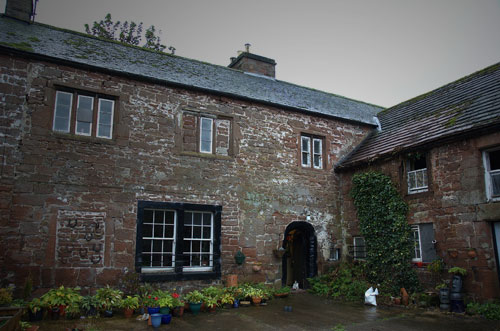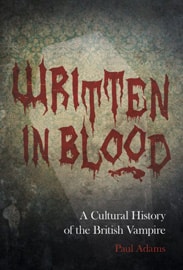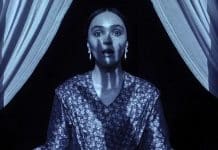The Vampire of Croglin Grange is one of England’s most intriguing blood-sucking tales. PAUL ADAMS, author of Written in Blood: The Cultural History of the British Vampire, looks at the case.

Among the great plagues of vampirism which spread across Eastern Europe during the seventeenth century, perhaps the most famous account is that of Arnold Paole, a Serbian soldier who became known as the Vampire of Meduegna.
Apart from the 12th century vampire-like revenants chronicled by medieval scholars Walter Map and William of Newburgh, instances of similar blood-drinking spectres down through the years are conspicuous by their absence.
What perhaps with a little stretch of the imagination could best be described as being our most suitable equivalent of the case of Arnold Paole is what Daniel Farson in his 1977 book, The Beaver Book of Horror, a popular supernatural guide written for children, called the ‘The British vampire’, but which is known more universally as the Vampire of Croglin Grange.
This well known story, centred around the small Cumbrian village of Croglin, twelve miles south-east of Carlisle in the very north of England, has over the years received a wide press and drawn the attention and comment of an impressive roster of writers and paranormalists including Montague Summers, D. Scott Rogo, Donald Glut, the Revd Lionel Fanthorpe and most recently Darren W. Ritson and Geoff Holder.
The basic story of The Vampire of Croglin Grange
All these authorities have attempted in various ways to establish the truth of the vampire story which typically runs as follows.
Three unnamed siblings, a sister and her two brothers, rent an old house known as Croglin Grange which lies in a remote spot overlooking a churchyard.
One night the young woman is disturbed by the sight of a figure moving across the lawn in the moonlight and soon a sinister brown skeletal apparition with glowing eyes appears at the bedroom window.
Petrified with fear, she watches as the creature picks away at the lead holding the window glass in place with its long bony fingers until one of the panes falls out and the figure reaches in, opens the window catch and is soon advancing across the room towards her.
Finally, as it drags her across the bed and sinks its teeth into her neck, the paralysis is broken and she utters a piercing scream which both alerts her brothers to the danger and also seemingly drives the vampire away.
The two men find their sister unconscious and bleeding from the throat while the beast of Croglin Grange makes its escape into the night.
The brothers take the young woman on holiday to a Swiss resort to recover from the experience but at her insistence they return to the Grange where all appears to be normal.
Several months later, again on a moonlit night, the sinister scratching sounds again at the window, heralding the appearance of the same cadaverous-looking horror.
This time the girl is able to scream a warning and her two siblings burst into the room, driving the apparition away. As it flees across the lawn, one of the brothers aims with a rifle and manages to fire a single shot into one of its legs.
The following morning the men follow a trail of fresh blood into the adjacent churchyard which leads them to the mausoleum of a local family.
Inside all of the coffins have been vandalized save one, which contains the brown and mummified creature with a lead slug lodged in its leg.
The usual ending to the tale is that the coffin and its contents are burnt to ashes, thus ending the rampage of the Vampire of Croglin Grange.
A barometer of belief and scepticism has swung across the Croglin case for over a hundred years since it was first brought to public attention in 1900 through the published memoirs of English author, Augustus Hare, a prolific travel writer, biographer and raconteur whose books include six volumes of autobiography issued in two fascicles in 1896 and 1900 under the collective title, The Story of My Life.
Hare’s memoirs include references to over a dozen ghost stories, all of which have fallen into obscurity save for “The Beast of Croglin Grange” which has survived to take on an unnatural life of its own.
Its origins date from 1874 when Hare swopped eerie after dinner stories with a neighbour, Captain Edward Fisher-Rowe and Henry Liddell, the 1st Earl of Ravensworth.
Fisher-Rowe regaled the company with a family story concerning a gruesome incident at his North Country estate, the particulars of which Hare remembered many years later and set down in the fourth volume of his memoirs.
Hare gave no names of the persons involved or dates of the alleged occurrences, but succinctly described Croglin Grange as a single-storey building with ‘a terrace from which large grounds sweep away towards the Church in the hollow, and a fine distant view’.
Less than 10 years later, Hare’s home-grown vampire story had been challenged and for all intents and purposes summarily dismissed: Charles Harper, an early English writer on haunted buildings, examined the case and in his 1907 book Haunted Houses included a number of salient points that cast much doubt on the accuracy of Hare’s narrative and the truth of Fisher-Rowe’s family yarn.
Croglin Grange appeared not to exist, only a building named Croglin Low Hall seemed to be relevant but its geography did not support several essential aspects of the story, being a two-story building over a mile from the local churchyard where a vault fitting the description of the vampire’s resting place was missing.
Another commentator to cast doubt on the story, albeit at a much later date, was D. Scott Rogo, a young American whose productive career in psychical research was to be cut tragically short when he was murdered in his Los Angeles home in 1980 at the age of 40.
Vampire of Croglin Grange tale similar to ‘Varney the Vampyre’
In an article published in the respected Fortean Fate magazine in 1968, Rogo drew attention to the disturbing similarity between the Croglin vampire’s method of entry into the young woman’s bedchamber and the opening chapters of James Rymer’s monumental ‘penny dreadful’ Varney the Vampyre.
Here the eponymous bloodsucker of the title menaces Flora, a damsel in distress, by breaking in through her bedroom window and is subsequently driven away by her men folk in an identical manner to Hare’s original account.
When the two accounts are read side by side it is difficult not to conclude that either Fisher-Rowe or Augustus Hare had a copy of Rymer’s book in their library or at some point in time had at least read its opening pages.
Despite the critical denouement, the Beast of Croglin Grange was nothing if not tenacious in its unwillingness to die.
Five years before Rogo had seemingly driven home the final stake, writer Francis Clive-Ross had achieved a partial rehabilitation which had appeared in the Tomorrow journal.
Although he had not discovered the smoking gun evidence for the existence of the undead, Clive-Ross had managed to substantiate or at least support several aspects of Captain Fisher-Rowe’s claims.
Croglin Low Hall was known as Croglin Grange up until the beginning of the eighteenth century and had at one time been a single-storey house, while a church, demolished during the English Civil War, originally stood adjacent.
The vampire story appeared to have been a long standing tradition in the Fisher-Rowe family and one blocked-up window of the house was identified as being the very point where the ‘beast’ had made its entrance.
In 1978, writer and novelist Marc Alexander (in his Haunted Churches & Abbeys of Britain) was able to add more vampires into the mix by relating an account of a former Croglin rector, the Revd Dr Matthew Roberts, who claimed that there was a story of vampire attacks and the sighting of a bat-like creature associated with the grave of another local clergyman, the Revd George Sanderson, who officiated in the village in the late seventeenth century.
In much the same way that the human drama of such cases as Borley Rectory and the ‘Amityville Horror’ has come under the investigative spotlight in recent years, in 2005, crime historian Richard Whittington-Egan was able to reveal similar aspects of the Croglin case that had previously gone unnoticed.
Whittington-Egan established that Captain Fisher-Rowe and his family were in fact themselves tenants of Croglin Low Hall rather than the owners as Augustus Hare had been led to believe, having taken on a lease in 1809 and that the vampire story was most likely passed on to them as an attractive local legend, either by the actual owner, a man named Johnson, or by surviving members of the Towry family who had owned the house from the late 1680s through until 1727.
Most recently, writer and researcher Geoff Holder has suggested that the vampire story may have its origins in the religious tension engendered by the 1662 Act of Conformity whereby Puritan ministers installed in country areas by the Commonwealth of England were dismissed by the restored monarchy under Charles II.
The Revd George Sanderson, identified by Marc Alexander as a possible source of the Croglin Grange vampire, was a former Puritan clergyman who sided with the Church of England and replaced the current rector at Croglin in 1671.
In so doing, Holder suggests he may have stirred up local ill feelings which have survived for posterity in later stories of vampires emerging from his grave at night to menace future occupants of Croglin Low Hall.
Whether “The Beast of Croglin Grange” was the aftermath of a religious dispute, a distortion over time of an actual but non-supernatural event (such as has been suggested an attack by a starving monkey from a local travelling circus), or a genuine paranormal phenomenon will it seems be a mystery that will never be solved for sure.
Watch Croglin Grange Vampire video
PAUL ADAMS is a Luton-based paranormal historian, writer and publisher. His latest is Written in Blood, a new examination of vampires and vampirism in British literature, film, music and television together with real-life cases including the Highgate Vampire, the Gorbals Vampire and Stoke-on-Trent’s Vampire of the Villas. Contains in-depth chapters on Stoker’s Dracula, the history of Hammer Films, Gothic and modern vampire literature and vampire-related murderers. It can be ordered from Amazon. He has written several other books on British ghosts and hauntings including Borley Rectory. Find out more at pauladamsauthor.co.uk Follow him @pauladamsauthor









It’s a great story though. True or false.